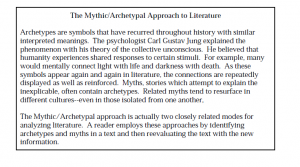Mary E. Illions Wilde and Professor Claudia Harris, English
For my project, I analyzed Zora Neale Hurston’s novel, Their Eyes Were Watching God, and D. H. Lawrence’s short story, The Horse Dealer’s Daughter, using the Mythic/Archetypal approach. First I identified the archetypes of water, light and mud in both works and intended to compare the way each author used them. As I proceeded with my research, however, I could not find any literary criticism that compared Hurston’s novel with Lawrence’s short story nor any criticism that focused on my topic in either of the works alone. I had stepped off an edge. The primary sources thus became rare, newly discovered manuscripts. Some secondary sources, though showing only a marginal relationship to my topic, still proved helpful. Because I had to search for connections, I held onto concepts that seemed to have little potential and squeezed out what was there. Sometimes I found juice and danced and bathed and laughed in it.
My project sprouted from the original light, water and mud to include animal imagery and the myths of the tree spirit and the external soul. After such expansion, a two page summary imposes an especially tight fit; therefore, I will give only a brief sampling of my discoveries.
Both Janie, in Hurston’s Their Eyes Were Watching God, and Mabel, in Lawrence’s The Horse Dealer’s Daughter, experience rebirth and individuation. Mabel’s development of self comes as a direct result of her symbolic baptism in the “foul earthy water”1 of a pond, whereas Janie’s occurs as a process in which symbolic baptism by hurricane flood waters is only a part. In The Horse Dealer’s Daughter, mud acts as a minor symbol and can represent death in Mabel’s cycle of rebirth. In Their Eyes, the opposition between the light and mud images serves as a model for the entire plot of the novel. Janie’s “self” begins to emerge as she learns to reject the limiting definitions her grandmother and her first two husbands place upon her. A “creation myth”2 appears early in the novel which connects Janie’s “self”—her most alive existence—to images of light and shine, and the forces that stifle her to images of mud and darkness:
When God had made The Man, he made him out of stuff that sung all the time and glittered all over. Then after that some angels got jealous and chopped him into a million pieces, but he still glittered and hummed. So they beat him down to nothing but sparks but each little spark had a shine and a song. So they covered each one over with mud. And the lonesomeness in the sparks make them hunt for one another, but the mud is deaf and dumb. Like all the other tumbling mud-balls, Janie had tried to show her shine.3
Janie, as described by Hurston at the end of the novel, has clearly chiseled away her
mud coating to uncover her shine: “[She] mounted the stairs with her lamp. The light in her hand was like a spark of sun-stuff washing her face in fire.”3 Lawrence also uses images of light to portray Mabel’s new existence: a “delicate flame … seemed to come from her face like a light.”1
Though both Janie and Mabel shine with new life and self-discovery, the two women are not sister characters. Unlike Janie, Mabel gains her light by mystical chance rather than effort or choice—she only emerges from the baptismal waters because Dr. Ferguson pulls her out. Also, Mabel’s shine seems altogether dependent upon Dr. Ferguson’s response to her. When she believes that he will reject her, it begins to fade: “Her eyes were now wide with fear, with doubt, the light was dying from her face, a shadow of terrible greyness was returning.”1 In contrast, Janie has earned her shine and thus owns it. At the end of the novel, she enters her house alone and the light goes with her.
As I have studied the rebirth of Mabel and Janie, the two works, Their Eyes Were Watching God and The Horse Dealer’s Daughter, have also become new. They emerge wrinkled from the juice of discovery, screaming and kicking. Janie and Mabel come out to see.
References
- Lawrence, D.H. (1995). The Horse Dealer’s Daughter. Ihe Norton Anthology of English Literature Vol 2, 6th ed. W. W. Norton: New York 2097-2108.
- Callahan . (1987). Mah Tongue Is in Mah Friend’s Mouff: The Rhetoric of Intimacy and Immensity in Their Eyes Were Watching God. Modern Critical Interpretations. Ed. Harold Bloom. New York: Chelsea House Publishers 87-113.
- Hurston, Zora Neale. (1965). Their Eyes Were Watching God. New York: Harper and Row.

